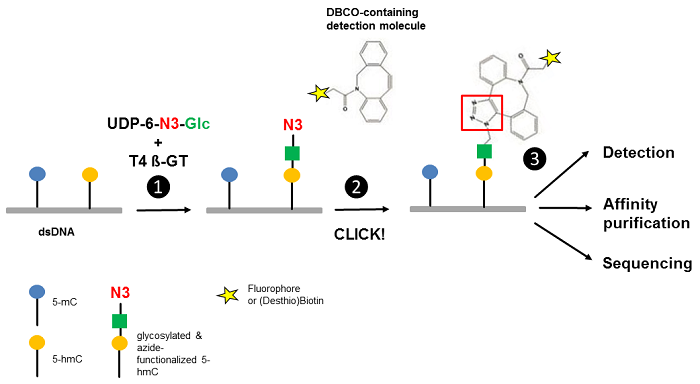5-hydroxymethylcytosine (5-hmC) is a DNA modification that is – along with its analog 5-methylcytosine (5-mC) – an important epigenetic marker associated with critical cellular functions such as stem cell differentiation and brain development[1]. A specific detection of 5-hmC however, is not trivial since traditional sodium bisulfite sequencing does not distinguish between 5-mC and 5-hmC sites[2].
Song et al.[3] reported an approach for the selective detection of 5-hmC residues in genomic DNA based on UDP-6-azide-glucose (UDP-6-N3-Glc) (Fig. 1). T4 Phage β-glucosyltransferase selectively transfers an azide-modified glucose moiety to the hydroxyl group of 5-hmC allowing detection via Copper-free strain-promoted alkyne-azide click chemistry (SPAAC) by

Figure 1 Workflow of 5-hmC detection. Step 1: T4 Phage ß-glycosyltransferase (T4 ß-GT)-mediated glycosylation and simultaneous azide-functionalization of 5-hmC residues using UDP-6-azide-glucose (UDP-6-N3-Glc). Step 2: Copper-free labeling of Azide (N3) with DBCO-containing detection molecule (DBCO-containing (Desthio)Biotin → Click Chemistry or DBCO-containing Fluorescent Dyes → Click Chemistry) forming a stable triazole moiety. Step 3: Detection, affinity purification or sequencing of 5-hmC containing DNA (modified according to [3]).
[1] Branco et al. (2012) Uncovering the role of 5-hydroxymethylcytosine in the epigenome. Nature Reviews Genetics 13:7.
[2] Huang et al. (2010) The behaviour of 5-hydroxymethycytosine in bisulfite sequencing. PLOS One 5(1):e8888.
[3] Song et al. (2011) Selective chemical labeling reveals the genome-wide distribution of 5-hydroxymethylcytosine. Nature Biotech 29(1):68.
[4] Li et al. (2012) Selective Capture of 5-hydroxymethylcytosine from Genomic DNA. J. Vis. Exp. 68:e4441.
[5] Song et al. (2016) Simultaneous single-molecule epigenetic imaging of DNA methylation and hydroxymethylation. PNAS 113(16):4339.